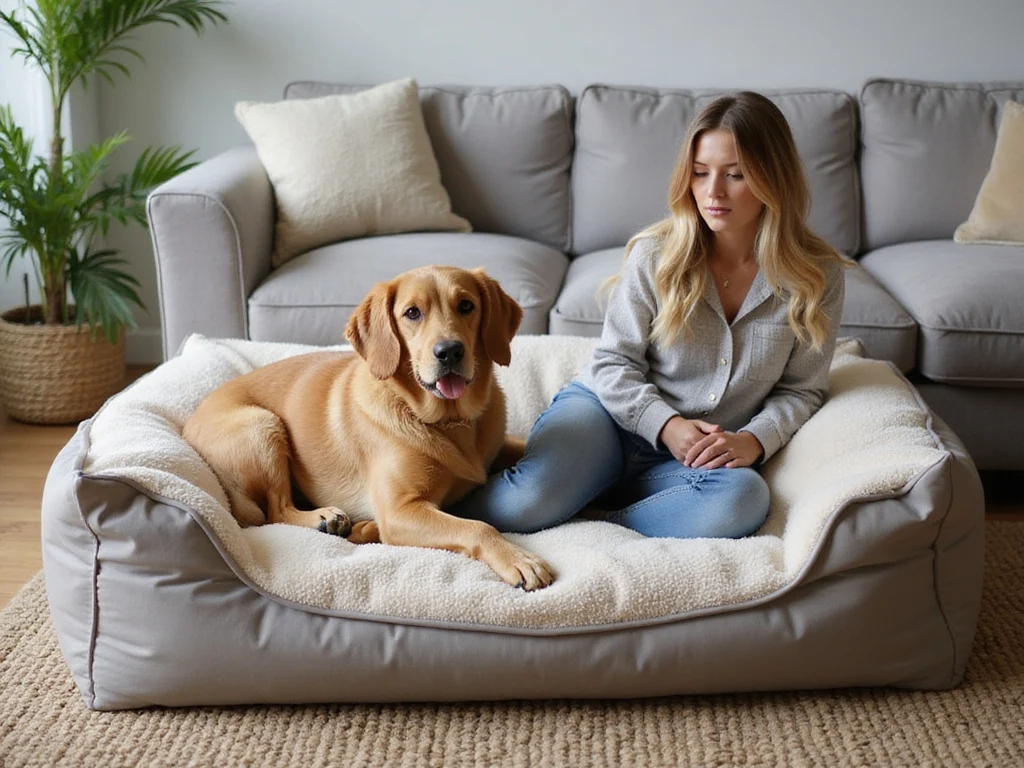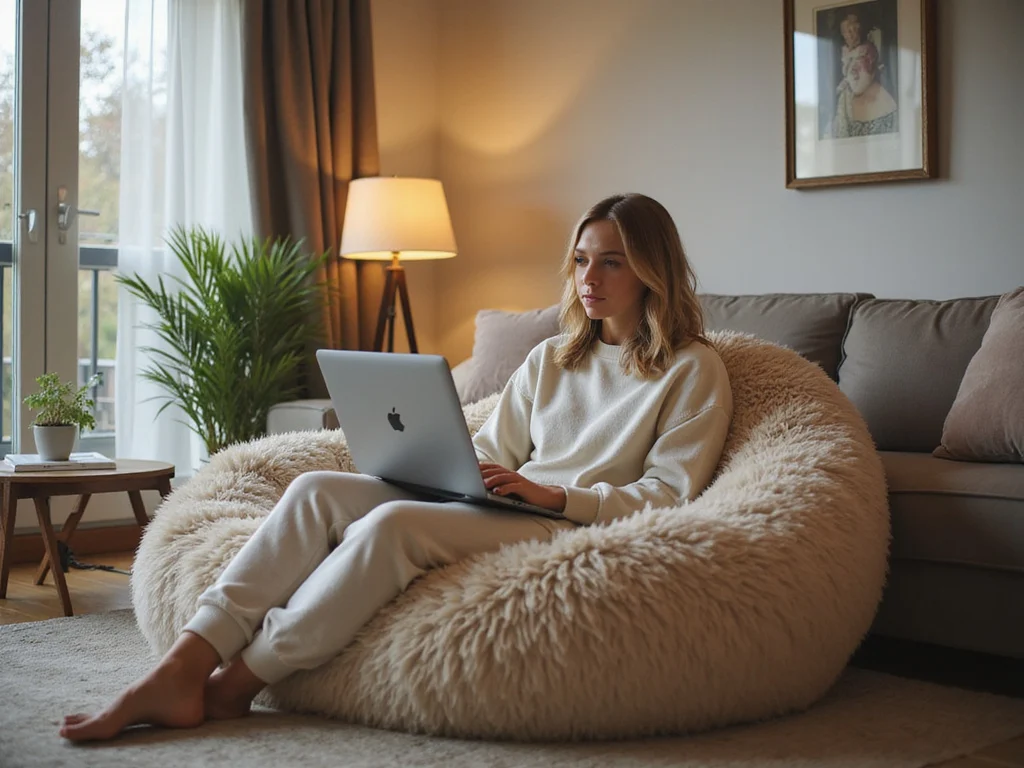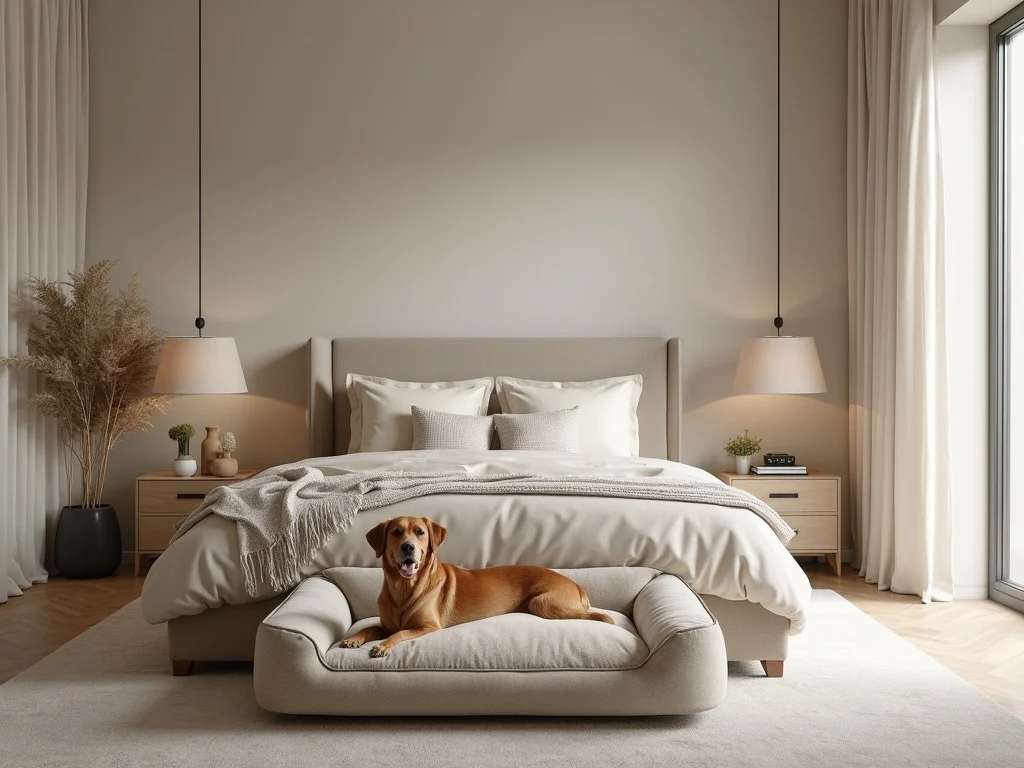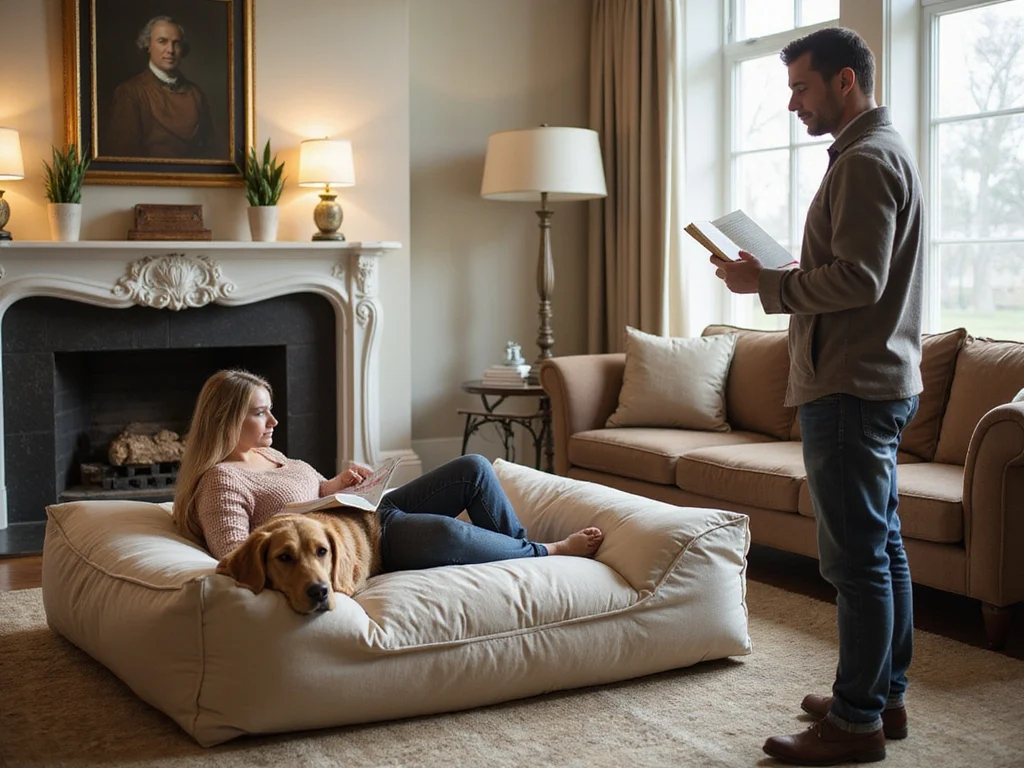The Ultimate Guide to Finding a Dog Bed Big Enough for Human Comfort
Have you ever watched your dog curl up in their bed looking incredibly comfortable and thought, “I wish I could join them”? Or perhaps you’ve experienced those nights when your furry friend hogs the bed leaving you with barely any space to sleep. The solution might be simpler than you think: a dog bed big enough for humans. This growing trend combines the comfort of a human bed with the coziness of a dog bed, creating the perfect space for both you and your four-legged companion to relax together.
In this comprehensive guide, we’ll explore everything you need to know about finding, building, or buying a dog bed that’s spacious enough for human use. We’ll cover design considerations, materials, benefits, step-by-step building instructions, and top recommendations for pre-made options. Whether you’re a DIY enthusiast looking to create a custom space or simply searching for the perfect ready-made solution, this article has you covered.
Why Consider a Human-Sized Dog Bed?
The concept of a dog bed big enough for humans isn’t just about novelty—it serves practical purposes that enhance the bond between you and your pet while addressing common challenges pet owners face.
One of the primary benefits is strengthened bonding with your pet. Dogs are pack animals by nature, and they crave close proximity to their human family members. A shared sleeping space creates opportunities for quality time together, whether you’re reading a book, watching TV, or simply relaxing. This physical closeness can reduce anxiety in both pets and humans, leading to improved well-being for everyone.
From a practical standpoint, a human-sized dog bed solves the common problem of pets taking over your bed. Many dog owners find themselves gradually relegated to smaller and smaller portions of their own mattresses as their pets stretch out. With a dedicated shared space, you can enjoy cuddling with your pet without sacrificing your sleep quality or comfort.
Additionally, these larger beds offer versatility that standard dog beds can’t match. They can serve as guest beds in a pinch, comfortable reading nooks, or even meditation spaces. Many designs incorporate storage options, making them multifunctional furniture pieces that maximize space efficiency in your home.
Design Options for Human-Dog Beds
When it comes to creating or selecting a dog bed big enough for humans, several design approaches can meet different needs and preferences:
Elevated Platform Beds
Elevated platform designs feature a raised human bed with an integrated dog bed underneath or beside it. This arrangement offers several advantages:
- Space efficiency, utilizing vertical space in your bedroom
- Clear boundaries between human and pet sleeping areas
- Proximity that allows for connection while maintaining separate spaces
- Cleanliness, as pet hair and dander remain primarily in their designated area
These designs work particularly well for those who want closeness with their pets without sharing the exact same sleeping surface. The elevated structure can incorporate steps or ramps for smaller or older dogs who might struggle with jumping.
Connected Side Beds
Connected side bed designs feature a dog bed that attaches directly to the side of your existing bed, creating an extension. Benefits include:
- Easy installation without requiring a complete bedroom overhaul
- Adaptability to various bed frames and sizes
- Removable options for flexibility
- Customizable heights to match your mattress level
Products like the ZAOWU Cat Hammock Bed utilize this concept, creating a comfortable attachment that turns your existing bed into a shared human-pet space. These are excellent options for those with limited space or renters who can’t make permanent modifications.
Oversized Floor Mattresses
Perhaps the simplest approach is an oversized floor mattress or cushion designed to accommodate both humans and pets. These offer:
- Maximum togetherness and cuddling potential
- Portability for use throughout the home
- Versatility as lounging, napping, or gaming spaces
- Easy storage options when not in use
This style works best for those who prioritize direct physical contact with their pets and don’t mind a more casual, lounge-style arrangement. Many DIY builders opt for this approach due to its simplicity and comfort.
Built-In Furniture Solutions
For those with carpentry skills or willing to invest in custom furniture, built-in solutions offer the most integrated approach:
- Custom dimensions tailored to your specific space
- Storage options incorporated into the design
- Seamless integration with your home’s aesthetic
- Potential for multiple pet accommodations in one structure
These permanent installations transform your bedroom into a pet-friendly haven while maintaining style and functionality. Their customizable nature means they can be adapted to any space constraints or aesthetic preferences.
DIY Guide: Building Your Own Human Dog Bed
Creating your own human-sized dog bed can be a rewarding project that results in a perfectly customized space for you and your furry friend. Here’s a comprehensive step-by-step guide to help you through the process:
Planning and Design
Before gathering materials or making cuts, take time to plan your project thoroughly:
- Measure your space – Determine exactly where the bed will go and how much room you have. Consider door clearances, walkways, and other furniture placement.
- Decide on dimensions – For comfort, aim for at least 75″ x 30″ for the human portion and an appropriately sized section for your dog based on their breed and sleeping habits.
- Sketch your design – Create a detailed drawing with measurements, noting how pieces will connect and where weight support is needed.
- Consider your skills – Be realistic about your woodworking abilities and choose a design complexity that matches your experience level.
Materials and Tools
For a basic platform-style human dog bed, you’ll need:
Materials:
- Lumber for frame (2x4s and plywood sheets are common choices)
- Foam mattresses or cushions (one human-sized, one dog-sized)
- Fabric for covers (durable, washable options like cotton duck, canvas, or microfiber)
- Waterproof liner material (especially important for the pet portion)
- Hardware (screws, bolts, brackets, corner braces)
- Finishing materials (paint, stain, or sealant)
- Optional components (storage drawers, steps, headboard materials)
Tools:
- Tape measure and pencil
- Circular saw or miter saw
- Drill with various bits
- Sander
- Staple gun (for attaching fabric)
- Sewing machine (for cushion covers)
- Level
- Safety equipment (goggles, gloves, ear protection)
Construction Process
Follow these steps to build your human dog bed:
- Create the base frame – Cut your 2x4s to the planned dimensions and assemble the rectangular base frame using screws and corner braces. Add cross supports every 12-16 inches for adequate mattress support.
- Add the platform – Cut plywood to size and attach it securely to the top of the frame. Sand all edges thoroughly to prevent splinters.
- Build the dog section – Depending on your design, create the dog bed portion either underneath (for platform beds) or alongside (for side-by-side designs). Ensure it’s proportional to your pet’s size.
- Add any extras – If your design includes storage, steps, or a headboard, construct and attach these elements now.
- Sand and finish – Sand all wooden surfaces smooth and apply your chosen finish (paint, stain, polyurethane). Allow adequate drying time between coats.
- Prepare cushions – Cut foam to size for both the human and dog sections. Create washable covers using your chosen fabric, incorporating zippers for easy removal and cleaning.
- Assemble the final bed – Place the cushions on the completed frame and make any final adjustments to ensure stability and comfort.
Customization Ideas
Make your human dog bed truly your own with these customization options:
- Integrated lighting – Install LED strips under the platform for nighttime visibility
- Pull-out drawers – Add storage beneath for bedding, toys, or dog supplies
- Removable covers – Create multiple cover sets for seasonal changes or easy washing
- Built-in dog toy storage – Incorporate small compartments for your pet’s favorite items
- Adjustable height options – For aging pets who may need easier access
- Heating elements – Add pet-safe heating pads for cold winter nights
- Privacy curtains – For dogs who sometimes prefer their own space
Pre-Made Options: Reviews and Recommendations
If DIY isn’t your strong suit, several manufacturers offer pre-made solutions that can accommodate both humans and pets:
PETIQUE Bedside Lounge Pet Bed
The PETIQUE Bedside Lounge stands out for its stylish design and practicality. This side-attachment style bed features:
- Eye-catching zebra print design that adds flair to bedroom decor
- Sturdy construction suitable for medium-sized dogs
- Comfortable cushioning that pets genuinely enjoy
- Easy attachment to standard bed frames
- Machine-washable cover for simple maintenance
User reports confirm that pets quickly adapt to this bed, appreciating their own space while remaining close to their owners. The height adjustment feature ensures it can match various mattress elevations for seamless integration.
ZAOWU Cat Hammock Bed
While “hammock” and “cat” appear in the name, this versatile product works excellently for small to medium dogs as well. Key features include:
- Plush nap mat that attaches securely to your bed frame
- Elevated design that creates a cozy den-like feeling pets love
- Sturdy wire frame that supports up to 20 pounds
- Beige neutral color that complements most bedroom decor
- Tool-free installation process
Particularly suitable for smaller breeds or cats, this hammock-style bed creates a snug sleeping environment while maintaining the close connection pets crave.
Cozy Cave XL Floor Cushion
For those preferring the oversized floor cushion approach, the Cozy Cave XL offers:
- Expansive surface area (approximately 60″ x 48″) comfortable for adults and large dogs
- Thick, supportive memory foam interior
- Removable, machine-washable microfiber cover
- Semi-raised edges that create a subtle boundary
- Portability for use throughout the home
This option works particularly well for casual lounging spaces like dens or media rooms where comfort takes precedence over formal furniture arrangements.
Custom Furniture Makers
For those with specific needs or design preferences, several furniture makers specialize in custom human-dog bed combinations:
- Etsy artisans – The handmade marketplace features numerous craftspeople creating bespoke pet furniture
- Local woodworkers – Many regions have skilled carpenters who can build to exact specifications
- Specialty pet furniture companies – Businesses focusing exclusively on high-end pet furnishings often offer human-compatible options
While custom options typically carry higher price tags, they offer the advantage of perfect sizing, material selection, and design integration with your existing decor.
Material Considerations for Comfort and Durability
Whether building or buying, the materials used in your human dog bed significantly impact its comfort, longevity, and maintenance requirements.
Frame Materials
The structural foundation of your bed demands durability and stability:
- Solid wood – Offers natural beauty and strength but may require more maintenance
- Engineered wood – More affordable and consistent than solid wood, though potentially less durable
- Metal – Provides maximum strength and longevity, particularly for larger dogs
- Combination approaches – Many successful designs incorporate multiple materials for optimal performance
Consider factors like weight capacity, visual appeal, and your home’s existing aesthetic when selecting frame materials. For DIY projects, kiln-dried hardwoods offer the best balance of workability and durability.
Cushion and Mattress Options
The comfort layer deserves careful consideration for both human and canine users:
- Memory foam – Conforms to body contours, excellent for joint support
- Latex foam – Naturally resistant to dust mites and mold, good for allergy sufferers
- High-density polyurethane foam – Affordable option that maintains shape well
- Orthopedic foam – Particular benefit for older dogs with joint issues
- Egg crate foam – Provides good air circulation and pressure point relief
For maximum comfort, consider a layered approach with firmer support foam beneath and softer comfort layers on top. This mimics high-quality human mattress construction while accommodating pets’ needs.
Cover Fabrics
The exterior fabric is your first defense against wear, stains, and pet damage:
- Canvas – Extremely durable and naturally resistant to tears from claws
- Microfiber – Soft, affordable, and relatively easy to clean
- Denim – Casual aesthetic with excellent durability
- Performance fabrics – Engineered options like Crypton or Sunbrella resist stains, odors, and bacteria
- Waterproof options – Essential for puppies, older dogs, or those with incontinence issues
Always opt for removable, machine-washable covers when possible. For extra protection, consider a waterproof liner beneath the main cover to shield the foam from accidents or spills.
Practical Considerations for Daily Use
Beyond the initial design and construction, several practical factors affect how well your human dog bed works in everyday life.
Cleaning and Maintenance
Regular maintenance keeps your bed fresh and extends its usable life:
- Weekly vacuuming – Remove hair and dander from surfaces
- Bi-weekly cover washing – Maintain fresh scents and eliminate bacteria
- Quarterly deep cleaning – Address foam and structural elements
- Spot cleaning kit – Keep enzymatic cleaners handy for accidents
Consider incorporating antimicrobial treatments on fabric surfaces and using protective covers during periods of heavy shedding. For households with multiple pets, having spare covers allows continuous use during washing cycles.
Placement and Integration
The location of your human dog bed affects its utility and your pet’s willingness to use it:
- Temperature considerations – Avoid direct sunlight or drafty areas
- Traffic patterns – Ensure the bed doesn’t obstruct natural movement through the room
- Privacy balance – Find the sweet spot between isolation and excessive exposure
- Proximity to activities – Position near family gathering areas for social pets
Many pet owners find that placing the human dog bed in bedrooms creates the ideal environment for nighttime bonding while maintaining sleep quality. Secondary lounging areas in living spaces can complement this arrangement.
Training and Transition
Introducing your pet to their new sleeping arrangement requires patience and positive reinforcement:
- Gradual introduction – Allow exploration before expecting overnight use
- Familiar scents – Transfer bedding items with established scents to the new bed
- Reward-based encouragement – Offer treats and praise for using the new space
- Consistent expectations – Establish clear boundaries about when and how the bed is used
Most pets adapt quickly to these shared sleeping arrangements, particularly when they recognize the benefit of remaining close to their human companions. Some may require several weeks of adjustment, especially if they’ve previously slept elsewhere.
Benefits Beyond Comfort: Health and Relationship Impacts
The advantages of a human-sized dog bed extend far beyond simple convenience, potentially improving both physical and emotional well-being for you and your pet.
Physical Health Benefits
Research increasingly shows that the sleeping arrangement you choose with your pet can influence physical health:
- Improved sleep quality – Dedicated spaces reduce disruption from pet movement
- Allergy management – Containment of pet hair and dander to specific areas
- Reduced joint strain – Properly supported sleeping surfaces benefit aging pets
- Temperature regulation – Separate but adjacent spaces prevent overheating
Additionally, many pet owners report that these arrangements help establish healthier sleep routines for both humans and animals, leading to more consistent rest cycles.
Emotional and Behavioral Advantages
The psychological benefits of shared sleeping spaces are equally significant:
- Anxiety reduction – Proximity without disruption can calm anxious pets
- Strengthened bonds – Physical closeness reinforces emotional connection
- Territorial satisfaction – Clear boundaries reduce resource guarding behaviors
- Security feelings – Both pets and owners report increased sense of safety
For pets with separation anxiety or those recovering from trauma, these close sleeping arrangements can play a crucial role in building trust and security while respecting the human’s need for undisturbed sleep.
Relationship Dynamics
Human-dog beds can also positively affect the overall dynamic between pets and their owners:
- Clear boundaries – Physical spaces that define appropriate closeness
- Balanced autonomy – Connection without complete dependence
- Mutual respect – Acknowledgment of both species’ needs
- Shared experiences – Creating dedicated time for bonding
Many pet behaviorists note that these arrangements strike an ideal balance between the human-animal bond and healthy independence, particularly important for breeds prone to attachment issues.
Cost Considerations: DIY vs. Pre-Made Options
The financial aspect of acquiring a human-sized dog bed varies dramatically based on your approach. Understanding the cost factors helps make an informed decision between building your own or purchasing a ready-made solution.
DIY Cost Breakdown
Building your own human dog bed typically involves these expenses:
- Lumber and hardware – $100-300 depending on wood quality and dimensions
- Foam and cushioning – $150-400 for human-grade comfort materials
- Fabric and finishing – $50-200 for durable, pet-friendly coverings
- Tools (if needed) – Variable cost if purchasing new equipment
- Time investment – Typically 15-30 hours for construction and finishing
Total DIY costs generally range from $300-900 depending on quality of materials and complexity of design. The most significant advantage is complete customization to your exact specifications and space constraints.
Pre-Made Option Pricing
Commercial human-dog bed options span a broad price spectrum:
- Budget attachable options – $50-150 for side-mounting pet beds
- Mid-range solutions – $200-500 for quality integrated designs
- Premium manufacturers – $600-1,500 for high-end custom pieces
- Designer furniture – $1,500+ for luxury craftsman-made options
The convenience factor of ready-made options can justify their higher price point, particularly for those without woodworking skills or appropriate tools. Additionally, commercial products typically come with warranties and return options not available with DIY projects.
Long-Term Value Considerations
Beyond initial costs, consider these factors when evaluating overall value:
- Durability – Quality materials may cost more upfront but last significantly longer
- Adaptability – Can the bed be modified as your pet ages or needs change?
- Resale potential – Well-crafted pieces may retain some value if no longer needed
- Multi-functionality – Designs serving additional purposes (storage, seating) offer better value
For many pet owners, the emotional value of a comfortable, shared space transcends pure financial considerations, making this an investment in quality of life rather than simply another furniture purchase.
Summary: Creating the Perfect Human-Dog Sleep Space
Finding or creating the ideal dog bed big enough for human use represents the perfect intersection of practicality, comfort, and the special bond we share with our canine companions. Whether you choose to build your own custom creation or select from available commercial options, the result is a dedicated space that honors the importance of your relationship with your pet.
The key to success lies in thoughtful consideration of your specific needs, your pet’s preferences, and the physical constraints of your living space. By balancing these factors with material selection, design aesthetics, and budget considerations, you can create a sleeping arrangement that enhances daily life for both two-legged and four-legged family members.
As this trend continues to grow in popularity, more innovative designs and purpose-built products will undoubtedly emerge. However, the fundamental principle remains timeless: creating a shared space that respects the needs of both species while celebrating the unique connection between humans and their canine companions.
Whether you’re solving practical sleeping challenges, addressing behavioral issues, or simply wanting to spend more quality time with your pet, a human-sized dog bed offers a versatile solution that can be customized to your exact requirements. The investment—whether financial, time, or both—pays dividends in comfort, convenience, and strengthened bonds for years to come.
Frequently Asked Questions About Dog Beds Big Enough for Humans
What materials do I need to make a human dog bed?
To make a human dog bed, you’ll need structural materials like lumber (2x4s and plywood), comfort materials including foam mattresses or cushions (one human-sized, one dog-sized), durable and washable fabric for covers such as cotton duck or microfiber, a waterproof liner (especially important for the pet portion), hardware (screws, bolts, brackets), and finishing materials like paint or stain. Optional components might include materials for storage drawers, steps, or a headboard. The specific quantities will depend on your chosen design dimensions.
What tools do I need to make a human dog bed?
Essential tools for building a human dog bed include a tape measure and pencil for accurate planning, a circular saw or miter saw for cutting lumber, a drill with various bits for assembly, a sander to smooth rough edges and prevent splinters, a staple gun for attaching fabric, a sewing machine for creating cushion covers, and a level to ensure proper alignment. Safety equipment including goggles, gloves, and ear protection is also crucial. If incorporating more complex features like drawers or custom joinery, additional specialized tools may be required.
Can I make a waterproof human dog bed?
Yes, you can make a waterproof human dog bed by using waterproof materials strategically. Start with a waterproof mattress protector or vinyl fabric as a base layer directly over the cushion foam. Next, add a middle layer of absorbent material like quilted cotton, then top with a removable, washable cover made from water-resistant fabric like outdoor canvas or specially treated upholstery fabric. For maximum protection, ensure all seams are sealed with waterproof tape or treatments. This multi-layer approach provides protection against accidents while maintaining comfort for both human and canine users.
How big should a human dog bed be?
The ideal size for a human dog bed depends on the size of both the human and the dog, along with the design style. For a shared sleeping surface, aim for dimensions similar to a twin mattress (approximately 38″ x 75″) as a minimum. For larger humans or dogs, or if you prefer more space, consider dimensions closer to a full mattress (54″ x 75″). For side-attachment designs, the human portion matches your existing mattress while the dog section typically ranges from 24″ x 36″ for medium dogs to 36″ x 48″ for larger breeds. Always account for your dog’s preferred sleeping position—stretched out, curled up, or sprawled—when determining the appropriate dimensions.
What are the best fabrics to use for a human dog bed?
The best fabrics for human dog beds combine durability, comfort, and ease of cleaning. Top choices include canvas (extremely durable and resistant to tears), microfiber (soft and relatively easy to clean), denim (casual aesthetic with excellent longevity), and performance fabrics like Crypton or Sunbrella that resist stains, odors, and bacteria. For maximum practicality, choose fabrics that are machine-washable, resistant to pet hair accumulation, and color-fast to withstand frequent cleaning. Dark colors or patterns can help hide stains and hair between washings. Consider using different fabrics for different purposes—a more durable material for the base and sides, with a softer, more comfortable fabric for the sleeping surface.
How do I train my dog to use a human dog bed?
Training your dog to use a human dog bed requires patience and positive reinforcement. Begin by placing familiar items with your scent and your dog’s scent on the new bed to create comfort and recognition. Encourage your dog to explore the bed using treats and praise, never forcing them onto it. Practice “place” or “bed” commands with rewards when they comply. Initially spend time with them on the bed during daytime hours to build positive associations. Maintain consistency by always directing them to the bed at appropriate times. For dogs accustomed to sleeping elsewhere, gradually transition by starting with nap times before expecting overnight use. Most dogs adapt within a few days to weeks, especially when they recognize the benefit of remaining close to their human companions.
For more information on creating custom pet furniture, visit The Owner Builder Network which offers detailed plans and inspiration for DIY projects.
To explore more options for elevated dog beds that work alongside human beds, check out Pawsitive Animal Works for comprehensive reviews and recommendations.



